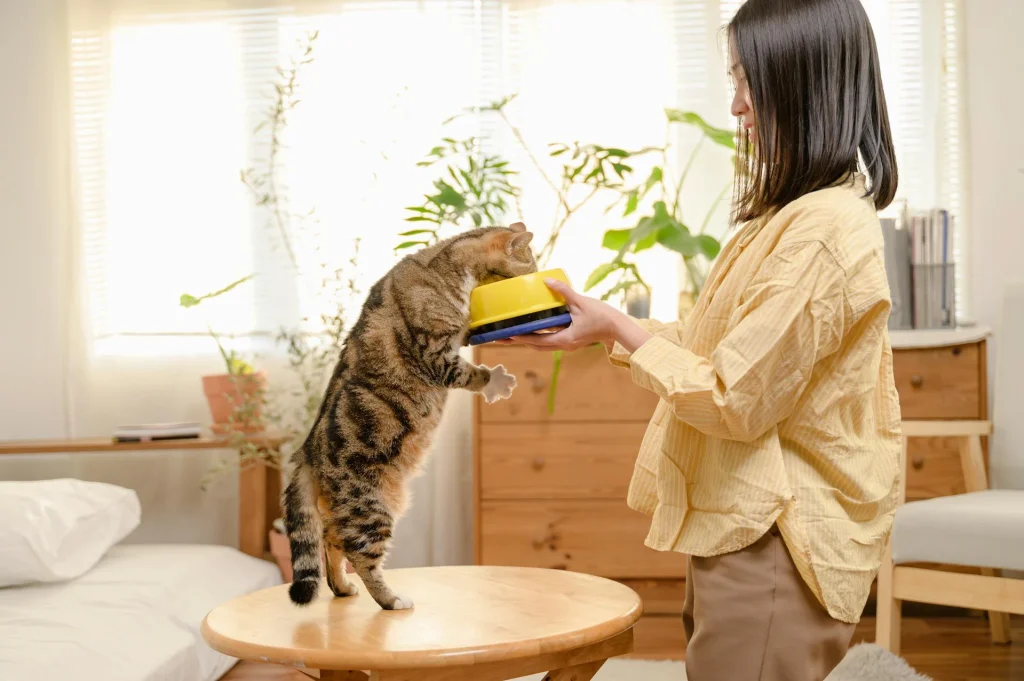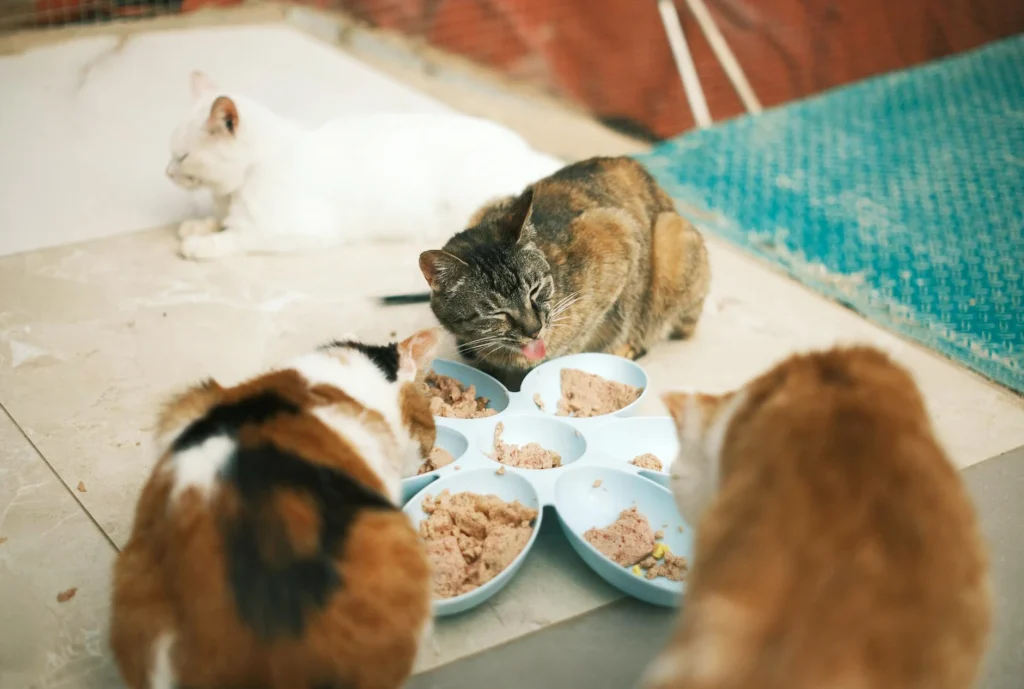If you have a diabetic cat and you are caring for its health, you are probably considering multiple options on how to turn his little life around. Perhaps you’ve already tried switching to canned food and you are now considering the most natural feeding type: raw food.
In this article we will explore the best raw food for diabetic cats, how you can meal prep yourself as well as purchase premade raw options.
Is Raw Food Good for Diabetic cats?
Yes, raw food is a good option for diabetic cats because it provides high amounts of proteins and low carbohydrates if any. Feeding your cat raw food supports healthy weight management and blood sugar levels.
If you are preparing the raw food by yourself, you have the most control over the ingredients, the quality of meat, bone and essential supplements. Depending on the recipe and how much you are willing to get invested in the process, it can require having a meat (and bone) grinder. Another option is to buy already packaged raw cat food mixes. You can also combine these mixes with certain important meats (like chicken liver).
What Natural Food Can I Feed My Diabetic Cat?
There are many natural food options you can consider feeding to your diabetic cat. The focus should be on providing high protein and low carbohydrate foods. Some of the naturally good options for your cat include:
- Chicken, beef, lamb, turkey or rabbit meat. Cooked without much oil or seasonings
- Organ meats (liver)
- Fish (salmon, tuna, sardines)
- Egg yolks
- Low-carb veggies (zucchini, spinach etc.)
These can be the base or used in addition to your raw food diet. Make sure to consult with your vet about raw feeding and if it is the right option for your cat.
What Is the Best Raw Food for Diabetic Cats in 2024?
Here are some brands that produce biologically appropriate raw foods for cats (BARF):
1. Primal Pet Foods
2. Smallbatch Cat
3. Darwin’s Natural Pet Products
4. Kiezebrink
5. Bella and Duke
6. PurrForm
7. Steve’s Real Food
All of these brands offer raw food options for your cat. Both frozen raw and freeze-dried. Some are based in the US and others are within the EU. Depending on your location you might want to reach out to the provider in case they support international shipping. Many of these brands like Darwin’s Natural Pet Products and Bella&Duke offer a subscription service and help you calculate the amount of raw food your cat needs daily. Afterwards it is a smooth experience.
If the raw food option does not include all of the needed supplements, there are brands like AniForte that offer supplements specifically for BARF diets.

Which Diabetic Cat Food is Best?
Almost any raw, wet or canned food is great for diabetic cats. As long as it is high quality, with high amounts of protein and low amount of carbs. Always, always check the label. And you can calculate the carbohydrate percentage by using this formula we mentioned in the original article Dry Cat Food for Diabetic Cats Without Vet Prescription
Let’s say you scroll around, click on a cat food and see a label with all these numbers:
- Protein: 8.0%
- Fat: 4.0%
- Fiber: 2.0%
- Ash (minerals): 2.2%
- Moisture: 82.0%
- Starch: 1.5%
Subtract these percentages from 100 to estimate the carbohydrates percentage in this cat food. Here is the formula:
Carbohydrates = 100 − (8.0 + 4.0 + 2.0 + 2.2 + 82.0 + 1.5)
Now, let’s calculate this.
What we get is 0.3% carbs, an approximate number that we can assume is the leftover carbohydrates. It is likely made up of other minor carbohydrates, aside from the 1.5% starch already given.
The actual carbs percentage can vary, it would most likely include both the starch and any residual carbs. That would be roughly 1.8% in total in this case.
By the way, the example we’ve used for the calculation is a Kattovit Diabetes/Weight product.
If you approach the diabetic cat food question with mindfulness and attention to detail, you can find great options on the market that fit both your cat and your budget.
What Not to Feed a Diabetic Cat?
Kibble. Pasta. Pizza. Anything sugary or sweet. Most of the human foods and treats are way too high in carbohydrates and sugars, so it’s best to avoid feeding these to diabetic cats. Dry foods containing grain, or cat food with gravy. Those can have high levels of carbohydrates, and carbs cause a spike in the blood sugar. Be mindful about what type of cat treats you give your cat, as some of them can contain sugar.
Risks of Raw Feeding Your Cat
Even raw feeding has some risks. The main one being sterility. Frequently handling raw meat can increase the risk of harmful bacteria being on your surfaces and getting into your, and your cat’s food. Luckily in frozen food, most of the bacteria has been killed off by the industrial freezing process. But be sure to clean your trays and equipment very well to avoid cross-contamination and foodborne illnesses.
Moreover, nutritional imbalance is a risk. With homemade raw cat feeding, we are at risk of miscalculating, forgetting, or simply not putting enough of the essential nutrients with the raw cat food. This can cause vitamin deficiencies in our feline friend and further health issues.Cats are in need of specific nutrients like taurine, calcium, vitamins and oils that are often missing in poorly organized raw diets.
And of course, every new diet change can cause stomach issues with cats. It’s a delicate process of getting them to switch and accept any new food. Some cats may not tolerate raw diets very well and can have vomiting and diarrhea symptoms. That can be risky for diabetic cats.
Can I Cook Raw Food For My Diabetic Cat?
Yes! You can cook for your diabetic cat, but it is crucial to check that your homemade food is nutritionally balanced. It needs to be high in protein, low in carbs, and contain all the necessary supplements. It is not optional. You would either need to include the mouse brains, hearts and livers in the bowl, or ensure that the Omega-3,6 and Taurine are provided as a supplement. It may be easier to provide that as part of the meat from chicken liver and as salmon oil. These are not the only supplements cats need, so make sure to familiarize yourself with everything related to essential nutrients for cats.

How Can You make Diabetic Cats Food at Home?
If you are planning to switch your diabetic cat to raw or home-made cat food, there are a few things to cross out first. Make sure that the first items on your shopping list are the following essential supplements. They would be later added to your homemade meat meal:
- Psyllium husk
- Omega 3,Omega 6 – Salmon oil or small fish oil (do not use cod liver oil)
- Taurine supplement – or chicken hearts
- Calcium from bone meal powder
- Vitamin A – usually from liver
- Vitamin E
- Vitamin B
- Vitamin D (d3)
- Iron (or red meats like beef)
- Choline (from eggs yolks)
- Probiotics
- Antioxidants (such as spirulina)
It may seem like a lot but most of these things can be found relatively easy in the pet store or online. Make sure they are formulated for animals, as the human supplements would be too high in dosage. Vitamin A, E and D can be found in fish oil alongside Omega-3 and Omega-6. But make sure to check the contents for the right dosage.
A simple home-made recipe for your diabetic cat could look like this:
- You would need 3 cups (~ 500g) of ground meat (chicken, turkey, beef or lamb).
- Then 1 cup (or ~150g) of chicken livers
- 25-50g of well-cooked vegetables (zucchini or spinach).
- Chicken fat (not too much, approx. 30g)
- 1-2 egg yolks (some cats might prefer them lightly cooked).
- All the essential supplements (see above, see below)
Mix all of these ingredients together, add supplements, then separate the mix into smaller portions of about 100 grams (⅔ cups) each. You can freeze them and then thaw it with warm water while it is in a zipped bag. Cats prefer their food to be only slightly warm, not hot. Whichever is closer to a mouse body temperature. But it is best to consult with the vet when it comes to the daily amount and portion size.
When it comes to adding nutrients to the specific recipe, keep in mind that some of the supplements are already included there. Such as the egg yolk and taurine which came from chicken livers. But you would need to care about adding calcium (for example from bone meal powder) and other minerals.
When preparing a raw meat diet for cats, it’s important to add specific supplements to ensure the meal is balanced. Here’s a general guide for supplement amounts per 100g of raw meat:
- Taurine: 200-250 mg
- Calcium: 400-500 mg
- Vitamin E: 1-2 IU (International Units) or 0.67-1.34 mg
- Vitamin B-complex: 50-100 mg (B-complex powder)
- Iodine (via kelp powder): 75-150 mcg
- Fish Oil (for Omega-3): 500 mg of fish oil (for EPA and DHA)
- Liver 5 -10g of raw liver (usually chicken or beef liver)
- Zinc: ~0.5-1 mg
- Magnesium: ~10-15 mg (optional, found in organ meats)
OR as another option, consider a supplement mix which should already have a balanced level of multiple dry supplements. Yes you might still need to get that Omega 3 and 6 oil.
How To Add Supplements Into Raw Cat food:
- Mix supplements into the raw mixture before dividing it into portions or freezing.
- Ensure the supplements are thoroughly mixed, so each portion is evenly balanced.
Summary of Best Raw Food for Diabetic Cats 2024
Now you should have an idea about how raw feeding a diabetic cat can work. Please keep in mind that this is a general guideline (!) And you should always consult with a veterinary nutritionist or follow a recipe tailored to your cat’s specific dietary needs. Each cat’s nutrient requirements can vary based on age, weight, and health condition. Especially for cats with diabetes. If you are considering switching them to raw cat food, please keep in mind all of the nutritional factors we went through in this article.

